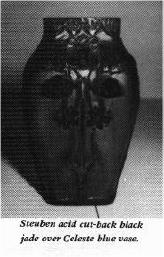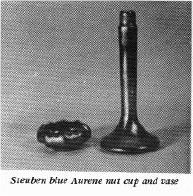National Depression Glass Association
Preserving America's Glass Manufacturing Heritage
Steuben Glass Works
by Shiela Zwirn
Rainbow Review Glass Journal - December 1973
The Steuben Glass Works at Corning, New York, was incorporated on
March 2, 1903, by Thomas G. Hawkes, Samuel Hawkes, Townsend DeM.
 Hawkes, and Frederick Carder. The new company was named "Steuben" for
the county in which it was located.
Hawkes, and Frederick Carder. The new company was named "Steuben" for
the county in which it was located.
Under Mr Carder's inspired direction, the Steuben Glass Works operated with great success. Mr. Carder remained with Steuben until 1934. Production of his successful wares did not stop with his retirement, However, their excessive cost in the face of the Depression put them on a gradual decline. The Steuben name is still associated with fine glass in America, but the company no longer makes the colorful wares Mr. Carder initiated.
Of all the wares made by Steuben, none were as popular as their Aurene. A great quantity of this ware in blue and gold lustre effects was made in the several years of production from 1904-1930.
The trademark "Aurene" was registered by the Steuben Glass Works on September 6, 1904. The name Aurene was coined by Mr. Carder and has its origin in the Latin word aureatus, "like gold in resplendence."
 In May 1959, Frederick Carder gave his explanation of the
manufacture of his Aurene glass:
In May 1959, Frederick Carder gave his explanation of the
manufacture of his Aurene glass:
"Aurene and Tiffany glasses" he wrote, "are not only iridescent but also metallic glasses. Salts of rare metals are dissolved in the glass and kept in an oxidized state. When a vase is made of this glass, and while it is still on the punty rod, it is subjected to a reducing flame. This brings to the surface a metallic coating. When developed in intensity, it is then sprayed with another metal Chloride (Tin salts dissolved in water). This puckers the surface of the glass into thousands of fine lines which reflect and refract light giving it a luminous quality."
Steuben's Jade glasses were actually nothing more than colored
opalines. By calling these translucent - colored wares "Jade," Mr.
Carder lifted them out of the commonplace to a more exalted position.
 The various colors in which these wares were produced can be found in
the opaline glasses made in glees factories in Europe and America in
the first half of the nineteenth century.
The various colors in which these wares were produced can be found in
the opaline glasses made in glees factories in Europe and America in
the first half of the nineteenth century.
The Steuben Glass Works made so many different types of glass, that I would have to write a book to explain all of them. Just a few types are Aurene, Tyrian Glass, Verre de Soio, Jade Glass, Ksuge Flambe, Transparent colored glasses, Peach Blow glass, Cluthra glass, Cintra glass, Quartz glass, Acid Cut-Backs, Bubble glass, Florentia, Opalescent glass, Clouded glass, Ivrene, Calcite, and Ivory Wares, Silverene glass, Moss Agata glass. Intarsia glass, Millefiori Teresa glassware, Millefiori Decorated Sculptured Vases, Matsu-No-Ke Cactus glassware, Grotesque glassware, Paperweight and Bubble-Balls, Heavy Cologne Bottles, Pressed glassware, Cast and Sculptured glass, Cire Perdu, and Diatreta. I think you can see what I mean.
Editor's Note: This is the second in a three-part series by Shiela Zwirn on Art Glass.